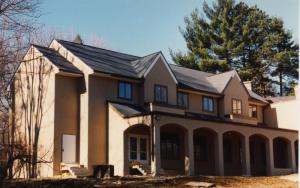Founding
In 1955, a handful of adventurous couple pioneers — the Kellmans, the Bergmans, the Jacobsons, and the Roberts — embarked on a journey to find a different, more personally enriching and inclusive Jewish religious experience. To read Joey Kellman’s personal reminiscences of the founding of Bet Am Shalom, click here. These pioneering individuals (about 20 member households) represented a wide range of Jewish experience, ranging from ultra Orthodox to ultra Liberal, but they shared a common goal — to find an interpretation of Judaism for modern times. Reconstructionist Judaism was the answer.
The group incorporated as Beth Shalom Synagogue in March 1956 and, with the help of Rabbi Mordecai Kaplan, the founder of Reconstructionist Judaism, the groundwork was laid for a new Synagogue
The community was without a home for several years. The members collected prayer books and kippot, traveled to members’ homes for Hebrew School and held Shabbat services in a variety of locations.
The nomadic period ended in 1958 with the purchase of a beautiful old mansion, “Clovelly,” in White Plains. The budding congregation hosted Rabbi Kaplan and Dr. Ira Eisenstein, another early Reconstructionist leader, at the first service in their new home.
In 1967, Beth Shalom and Bet Ami merged to create Bet Am Shalom Synagogue.

We Grow
Membership grew slowly (to185 member households) until 1989, when Rabbi Lester Bronstein, and his wife, Cantor Benjie Ellen Schiller, became our spiritual leaders. That year we also undertook our first renovation and expansion to build a new simcha room, library and classrooms to accommodate the growth in our membership. By1991 our membership was 244 households. That year we dedicated our new space with an inscription from the book of Nehemiah (3:38), “For the People’s Heart Was in the Work.”
While we continued to grow, our membership stayed true to its special intimate character and its sense of community. But our physical space couldn’t accommodate the life of the community. In 2001, we began plans to expand the synagogue once again.
Setback
But on September 9, 2003, while planning for the expansion, an electrical fire destroyed the stone and wood structure of our original building. Our community survived for 18 months holding services in the gym at Temple Israel Center, Hebrew School at Solomon Schechter, and our administrative offices at UJA and then in a trailer on our property.

We Overcome
We returned to a partially restored building in December 2004 with a candlelight parade of Torahs. Several months later, work was completed and we returned to an entirely rebuilt synagogue including new offices, classrooms, library and a bet midrash. Work continued on an expanded sanctuary.

Finally, our rebuilding and expansion was completed three years after the fire, on September 10, 2006, the new sanctuary was dedicated.


We now have a beautiful communal home in which to hold weekly Shabbat services, simchas, holiday celebrations and our Judaica craft show.
